Figure 5-1: Google Trends.
Introducing the Tools
You can’t monitor your online reputation without the right tools. A great number of tools are available, and in the following sections I cover a number of favorites. Different tools are appropriate for different organizations, of course, so here I break them down according to cost. For example, when I reference “smaller” tools, I’m mostly referring to tools that are a good fit for small businesses because of the price point and range of services. Larger, more comprehensive (and expensive) tools dig deeper into the data stream and slice up more closely defined areas of information into more detailed reports cost more. The most cost-effective tools are the easiest to learn and manage on your own. More advanced platforms offer greater customer service and training benefits. So no matter whether you’re responsible for a small business or a Fortune 100 company, you should be able to get started quickly.
I suggest using three tools in tandem with each tool measuring something different. You will get a much clearer picture when you can look from three viewpoints.
A number of propriety services are also available. Ideally, a proprietary monitoring service is custom made to fit an organization’s specific hardware and software needs. It’s like getting a suit expertly tailored to fit your body perfectly. This tailor is your best source for information on how the suit is made and can keep up with alterations as needed. Because of this, I can’t cover proprietary platforms, but please keep in mind that this is a very new area, and it’s much more complicated to get quality results than meets the eye.
Keep in mind that new tools spring up overnight, and even the most reputable tools will continue to add to their features over time. Some of the tools I describe here may be different by the time you look at them.
Using small-business tools
This section is ideal for entrepreneurs. The following tools have limited capabilities and involve a lot of manual research, but it’s hard to beat the price. In Chapter 7, I go into much greater detail about the tools on this list and show you how to set up these accounts for yourself:
![]() Google Alerts are e-mails sent to you when Google finds new results — such as web pages, newspaper articles, or blogs — that match the search terms you set. You can find them at
Google Alerts are e-mails sent to you when Google finds new results — such as web pages, newspaper articles, or blogs — that match the search terms you set. You can find them at www.google.com/alerts
. This service is free.
![]() Google Trends is a free service that explores how often topics have been searched via Google over time. You can find it at
Google Trends is a free service that explores how often topics have been searched via Google over time. You can find it at www.google.com/trends
. Figure 5-1 shows you how easy it is to get started. Enter up to five topics and see
• How frequently they have been searched via Google
• How frequently they have appeared in Google News stories
![]() Which geographic regions have searched for them the most
Which geographic regions have searched for them the most
![]() Social Mention is a free service that provides daily e-mail alerts like Google Alerts does, but it searches social media. Receive daily e-mail alerts to see the latest real-time buzz about you, your blog, brand, product, or company.
Social Mention is a free service that provides daily e-mail alerts like Google Alerts does, but it searches social media. Receive daily e-mail alerts to see the latest real-time buzz about you, your blog, brand, product, or company.

![]() HootSuite is a service that you can either access for free or upgrade to its Pro version for $5.99 a month, depending on which features and capabilities you need. HootSuite has surprisingly robust analytics and is well designed for individual or team use. Its popular dashboard enables you or your team to monitor conversations and track the success of campaigns. The free, ad-supported version can be used for up to five social profiles. You can check it out at
HootSuite is a service that you can either access for free or upgrade to its Pro version for $5.99 a month, depending on which features and capabilities you need. HootSuite has surprisingly robust analytics and is well designed for individual or team use. Its popular dashboard enables you or your team to monitor conversations and track the success of campaigns. The free, ad-supported version can be used for up to five social profiles. You can check it out at www.hootsuite.com
.
![]() TweetDeck is a free service offered by Twitter that you can find at
TweetDeck is a free service offered by Twitter that you can find at www.tweetdeck.com
. (See Figure 5-2.) It’s constantly evolving, packed with features, and is also easy to use. Like HootSuite, TweetDeck offers
• Columns, which organize streams of information, such as your mentions on Twitter, comments on Facebook, and saved Twitter searches.
• Scheduling of updates, which give you around-the-clock flexibility. For example, you can sit down a month before a special event and schedule notifications over Twitter and Facebook.
• Filtering capabilities, which give you the power to save specific searches about anything you may find useful.
Figure 5-2: TweetDeck.
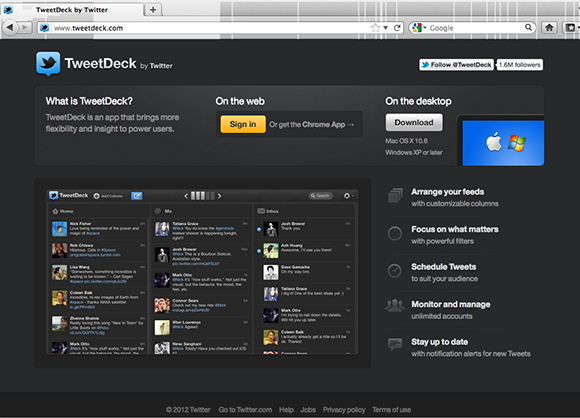
![]() Trackur (simple plan): $18 to $377 per month, depending on features and capabilities. This is the simplest version of Trackur, and it includes
Trackur (simple plan): $18 to $377 per month, depending on features and capabilities. This is the simplest version of Trackur, and it includes
• Saved searches, which give you the power to save specific searches about anything you may find useful, whether it’s your name, your organization’s name, your industry, or even a competitor.
• RSS/e-mail alerts, which send you the kind of information you designate either via RSS (Really Simple Syndication, a family of web feed formats used to publish frequently updated works, such as blogs) or by e-mail.
• Sentiment tagging, which refers to the way people seem to be emotionally responding to the term. This doesn’t work perfectly because the way people express themselves tends to vary by geographic region. A kid in Boston may call last night’s concert “wicked” and mean it as a compliment, but a sentiment tracker may gauge it as a negative comment. There is still a lot of room for this technology to grow, though it is still really useful to get a handle on a general trend. (For more on sentiment tagging, see the section, “Getting sentimental,” later in this chapter.) I discuss the more advanced version of Trackur in the next section.
• CSV export, which enables you to transfer data into Spreadsheet applications like Excel.
• Coverage of Twitter, Facebook, and Google+.
• Influence metrics, which give you information about the kind of online influence that your commenter enjoys.
Using medium-sized businesses tools
At present, the cost of these tools ranges from about $400 to $1,000 a month, but this is subject to change as features change:
![]() Meltwater Buzz: This tool offers social media monitoring, direct social engagement, and social customer relationship management (CRM). Provides deep insight into communications happening across the social web. You can find it at
Meltwater Buzz: This tool offers social media monitoring, direct social engagement, and social customer relationship management (CRM). Provides deep insight into communications happening across the social web. You can find it at http://buzz.meltwater.com
. (See Figure 5-3.)
![]() Radian6 (basic plan): This is a more simplified version of the Radian6 tool described in the next section, but it’s still robust and highly competitive with the other platforms in this category. You can find more information about both Radian6 plans at
Radian6 (basic plan): This is a more simplified version of the Radian6 tool described in the next section, but it’s still robust and highly competitive with the other platforms in this category. You can find more information about both Radian6 plans at www.radian6.com
.
Figure 5-3: Meltwater Buzz.
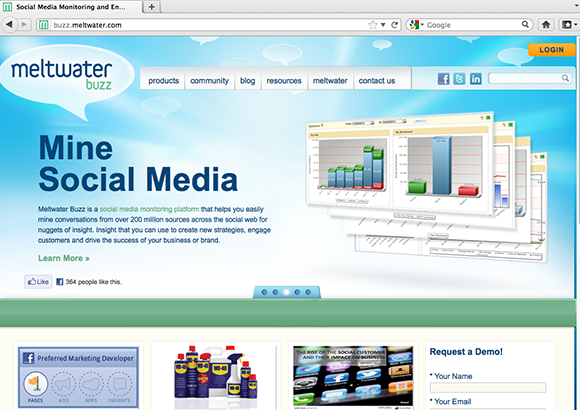
![]() Trackur (advanced plan): This plan includes RSS/e-mail alerts; sentiment tagging; CSV export; coverage of Twitter, Facebook, and Google+; influence metrics; analytical insights into the information you see; the capability to group results by profile; and branding number of other features for companies offering branded social media services. You can check it out at
Trackur (advanced plan): This plan includes RSS/e-mail alerts; sentiment tagging; CSV export; coverage of Twitter, Facebook, and Google+; influence metrics; analytical insights into the information you see; the capability to group results by profile; and branding number of other features for companies offering branded social media services. You can check it out at www.trackur.com
.
![]() Lithium: Lithium is a social CRM and social listening tool. Lithium’s social media monitoring platform is fairly simple to set up, shows results in real time, and finds the best content via social media. You can check it out at
Lithium: Lithium is a social CRM and social listening tool. Lithium’s social media monitoring platform is fairly simple to set up, shows results in real time, and finds the best content via social media. You can check it out at www.lithium.com
where you can sign up for a free trial and get customized pricing information.
![]() MutualMind: Ranked as a top-tier, social media monitoring application, MutualMind packs lots of features, including coverage of consumer trends and sentiment. Pricing packages start at $500 a month, and you can find out more at
MutualMind: Ranked as a top-tier, social media monitoring application, MutualMind packs lots of features, including coverage of consumer trends and sentiment. Pricing packages start at $500 a month, and you can find out more at www.mutualmind.com/plans-and-pricing
. (See Figure 5-4.)
Figure 5-4: MutualMind.
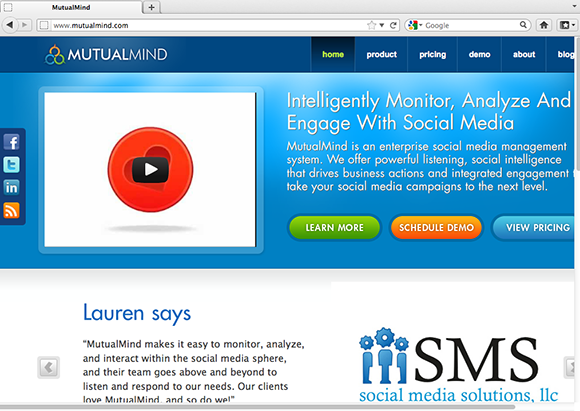
Reviewing tools for large-sized businesses
Here’s the big end of the scale. The major difference between the tools I have already discussed and these high-end tools is that with these tools you can ask much more specific questions and search significantly larger pools of information. Each one of these high-end tools is distinct, but each of them provides information about search engine results and about
![]() Blogs, such as LiveJournal, TypePad, Tumblr, and WordPress.com
Blogs, such as LiveJournal, TypePad, Tumblr, and WordPress.com
![]() Message boards and forums
Message boards and forums
![]() Microblogs, such as Twitter and Plurk
Microblogs, such as Twitter and Plurk
![]() Video-sharing sites, such as YouTube and Vimeo
Video-sharing sites, such as YouTube and Vimeo
![]() Photo-sharing sites, such as Flickr, Pinterest, and Picasa
Photo-sharing sites, such as Flickr, Pinterest, and Picasa
![]() Wikis (sites that allow anybody to change or update definitions)
Wikis (sites that allow anybody to change or update definitions)
![]() Social networks, such as Facebook, LinkedIn, and Ning
Social networks, such as Facebook, LinkedIn, and Ning
![]() Classified-ad sites, such as Craigslist
Classified-ad sites, such as Craigslist
![]() Review sites, such as ePinions and Angie’s List
Review sites, such as ePinions and Angie’s List
Whether or not to make the jump to using these higher-end monitoring tools can be a big decision. They aren’t for everyone. Unless you’re running social media for a large-scale brand or organization, you can probably get the job done without making this kind of monthly investment. Monthly usage rates for these tools range from about $900 to $3,500 a month, but this is also subject to changes in the technology and pricing structures.
![]() Radian6 (advanced plan): Radian6 is an integrated platform that gives you near real-time access to social insights like the ones that follow. It’s also scalable within an organization, so you can designate which department responds to certain comments. You can learn much more and sign up for a free trial at
Radian6 (advanced plan): Radian6 is an integrated platform that gives you near real-time access to social insights like the ones that follow. It’s also scalable within an organization, so you can designate which department responds to certain comments. You can learn much more and sign up for a free trial at www.radian6.com
(See Figure 5-5.) This platform offers
• Demographics, which give you as much age and gender information as your commenters share on their social profiles.
• Geolocation, which helps you to isolate how different geographic regions are responding via social media to a commercial you are airing, for example.
• Influence, which tells you about the audience sizes people enjoy online.
• In-depth sentiment, which takes a deeper, more exact plunge into online activity that tells how people are feeling about your search terms (in this case, your brand).
• Topic categorization, which gives you the ability to organize conversations by topic.
![]() Sysomos: Sysomos provides tools that measure, monitor, and engage within the social media landscape. As with the other tools in this section Sysomos provides instant access to all social media conversations from blogs, social networks, and microblogging services to forums, video sites, and media sources. You can learn more and sign up for a free trial at
Sysomos: Sysomos provides tools that measure, monitor, and engage within the social media landscape. As with the other tools in this section Sysomos provides instant access to all social media conversations from blogs, social networks, and microblogging services to forums, video sites, and media sources. You can learn more and sign up for a free trial at www.sysomos.com
.
Figure 5-5: Radian6.
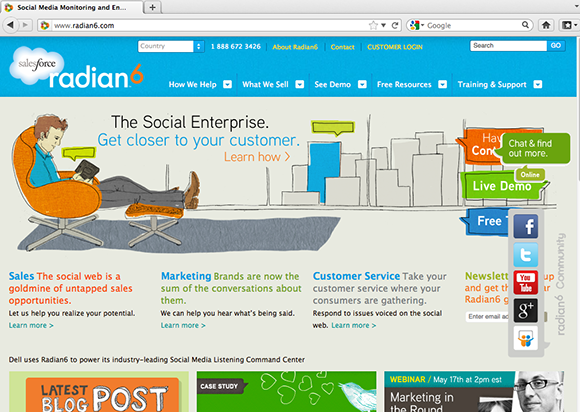
![]() Alterian SM2: This is another business intelligence tool that provides a comparable level of visibility into social media channels and lets you tap in to what customers are saying about you and your product. You can check it out and opt in for a free trial at
Alterian SM2: This is another business intelligence tool that provides a comparable level of visibility into social media channels and lets you tap in to what customers are saying about you and your product. You can check it out and opt in for a free trial at www.alterian.com/social media/products/sm2
.
![]() NetBase: This is an enterprise-level social intelligence platform. It offers a way to operationalize social media by instantly capturing billions of social media conversations from millions of sites globally. It offers sentiment analysis and clean, normalized data that has been filtered to remove irrelevant content. (
NetBase: This is an enterprise-level social intelligence platform. It offers a way to operationalize social media by instantly capturing billions of social media conversations from millions of sites globally. It offers sentiment analysis and clean, normalized data that has been filtered to remove irrelevant content. (www.netbase.com
)
![]() Visible: Visible (
Visible: Visible (www.visibletechnologies.com
) is a social media monitoring and analytics platform. It analyzes social media conversations to better understand consumer preferences, market dynamics, competitive strengths and weaknesses, and other information critical to the company’s reputation and brands. (See Figure 5-6.)
Figure 5-6: Visible.
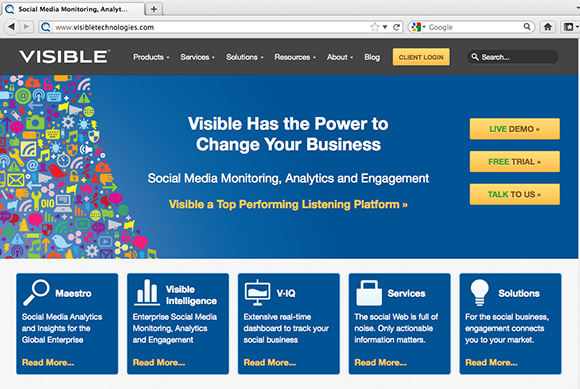
Getting sentimental
Some of the tools I mention earlier offer what’s known as sentiment analysis. This basically means you can program the tool to determine whether commenters are expressing positive or negative feelings. This can be pretty terrific, but it has some definite limitations, such as difficulty discerning ironic comments, sarcasm, or regional differences in speech, such as “bless her heart,” which, down south where I live, is not a compliment.
For example, if a New Englander comments that a concert was wicked sick, she loved it. Few people in the Southeast, however, would use the word “wicked” to describe something they liked. Sentiment analysis tools are useful, but they haven’t quite caught up with some of these regional differences.
One of the most effective, yet cost-effective (meaning: It’s free!) resources you can use to check sentiment involves a little bit of time and effort, but it gives you direct access to what people are actually saying about
![]() You
You
![]() Your brand
Your brand
![]() Your industry
Your industry
![]() Customer service opportunities
Customer service opportunities
![]() How well your advertising campaigns are doing
How well your advertising campaigns are doing
![]() How well your crowdsourcing campaigns are doing
How well your crowdsourcing campaigns are doing
This tool is Twitter Search (www.twitter.com/search
). Twitter Search is simple to use. Just enter your search term, and the result shows up, complete with time stamp. (See Figure 5-7.)
Figure 5-7: Twitter Search.
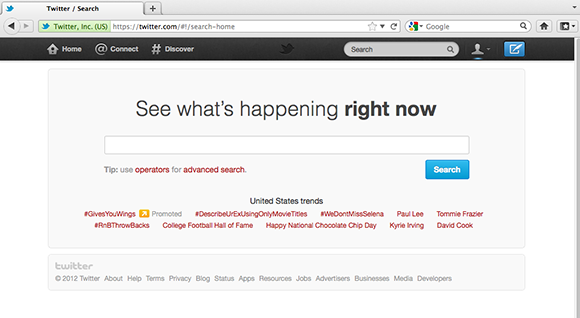
Here, I’ve searched using the term chicken wings. (I chose the term because chicken wings are my younger son’s favorite food.) (See Figure 5-8.) From the results, I can track
![]() People who tweet about chicken wings
People who tweet about chicken wings
![]() Top videos of chicken wings
Top videos of chicken wings
![]() Top images of chicken wings, for when you want to know what the most popular images have been over time
Top images of chicken wings, for when you want to know what the most popular images have been over time
![]() The very latest tweets mentioning chicken wings. This is a great way to see how people are feeling about a given topic and exactly what they’re saying about it right now
The very latest tweets mentioning chicken wings. This is a great way to see how people are feeling about a given topic and exactly what they’re saying about it right now
Twitter Search is particularly cool because you can take a virtual snapshot of how people are feeling about something. A Twitter search for “chicken wings” will result in a list of tweets describing places where people eat wings, how much they love them, how to prepare them, and so on. A Google search, on the other hand, would give you the major chain restaurants that happen to sell chicken wings. Regular people’s comments on the matter rank very low in Google’s search algorithms.
Figure 5-8: Twitter Search for chicken wings.
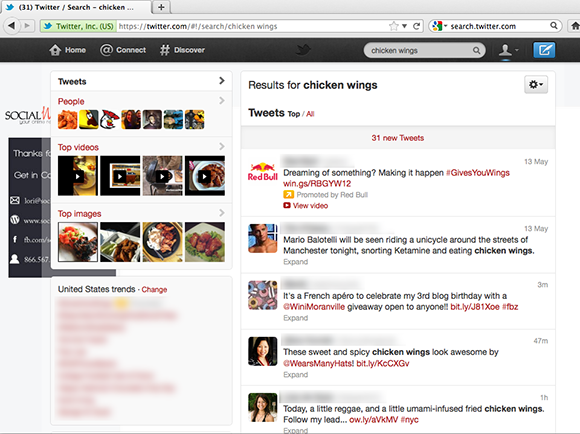

 Everybody can benefit from using the free and more cost-effective tools, but the larger an organization gets, the more it can benefit from tools that dig more deeply into the massive pool of information and share information that the simpler tools miss. If this is you, check out the larger scale tools I share further into this Chapter. I show you how to set up the simple tools in Chapter 7.
Everybody can benefit from using the free and more cost-effective tools, but the larger an organization gets, the more it can benefit from tools that dig more deeply into the massive pool of information and share information that the simpler tools miss. If this is you, check out the larger scale tools I share further into this Chapter. I show you how to set up the simple tools in Chapter 7. If you hire a professional to develop a proprietary, in-house system, I suggest checking her references closely and making sure that she develops something that integrates into your existing systems as seamlessly as possible. Ask her about what kind of results she has delivered for others and what kind of training and maintenance she will agree to.
If you hire a professional to develop a proprietary, in-house system, I suggest checking her references closely and making sure that she develops something that integrates into your existing systems as seamlessly as possible. Ask her about what kind of results she has delivered for others and what kind of training and maintenance she will agree to.